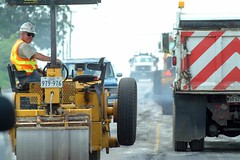New data on the missed opportunity of the stimulus

Posted December 1, 2009 at 1:44PM
By now, we all know that the American Reinvestment and Recovery Act, usually referred to as "the stimulus bill," wasn't particularly green. The emphasis on "shovel-ready" projects inherently favored highway projects and other dubious undertakings. My own pet peeve about the bill is that it did absolutely nothing for transit operating and maintenance expenses, which could have added and saved jobs while helping businesses near transit stops. That omission could not have come at a worse time for public transportation, which had been experiencing significant growth in ridership simultaneously with losses of revenue as municipalities' tax receipts declined with falling property values.
 Now, thanks to Shari Shapiro's Green Building Law blog, we have analysis of the first 10 months of spending, and it confirms that the stimulus to date has been far more brown than green:
Now, thanks to Shari Shapiro's Green Building Law blog, we have analysis of the first 10 months of spending, and it confirms that the stimulus to date has been far more brown than green:
"The overall spending-i.e. money that has been paid out for green projects-in the first 10 months of 2009 amounts to over $1.5 billion. This is not nothing, and a vast improvement from the summer. On the other hand, $83.8 billion has been paid out in tax benefits as of 11/06/09, and allocation on highway infrastructure by the Department of Transportation alone was $20.2 billion of which $3.7 billion has been paid out."
Shari goes point-by-point through the categories of spending that have been green, including renewables and energy efficiency, transit, green buildings, and EPA, and I recommend her post to everyone interested in the topic.
Another provocative blog post on the stimulus concept comes from Charles Marohn, writing on the Strong Towns Blog. His position is that "we already have more infrastructure than we can afford to maintain and this imbalance, combined with the massively inefficient development pattern it has induced, is the real drag on the economy. Building even more infrastructure on this same model is simply digging the hole deeper."
He further argues that spending on infrastructure maintenance and improvement should be subject to analysis of its effect on community value, including property values, and that the winner under this kind of scrutiny will be retrofits of existing communities "to be mixed-use with complex, urban streets."
The environment, and existing communities, got shortchanged in ARRA. Let's make sure it doesn't happen again.